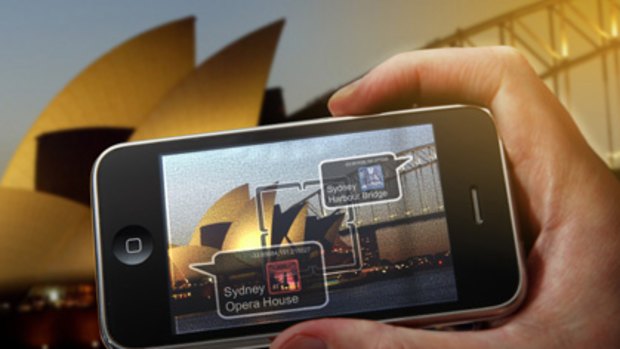By Gordon Farrer
Welcome to augmented reality, the digital revolution that integrates location and data.
I'm standing at the corner of King and La Trobe streets in central Melbourne, facing the Flagstaff Gardens across the road. I've been here many times but today I'm looking at the gardens in a new way — through my phone.

An example from the Wikitude augmented reality application.
When I point the phone's camera at the gardens, a flotilla of text bubbles pops up and bobs across the screen. Point the camera in a new direction and some bubbles drift out of view as new ones drift in.
Click on any bubble and an information box comes up. This box is for a nearby cafe, that one for a hotel, those others for a range of points of interest: the gardens themselves and, beyond, Old Melbourne Gaol, Victoria Market, the Eureka Skydeck and Federation Square.
There are many other bubbles on the screen — for businesses, landmarks, sporting venues, dozens more natural features — all containing location descriptions, facts about the subject, opening hours, user star ratings, links to web pages and so on.
Welcome to augmented reality, the digital revolution that integrates location and data.
Augmented reality enables mobile browsing of the world, to help explore and experience it more thoroughly. It's a lot like "real" reality, only more more useful. And while still in its early days, it promises to enrich the world in ways barely imaginable.
The key to augmented reality is geolocation, that facility of the latest generation of mobile phones that include inbuilt global positioning system (GPS) functions.
Most owners of smartphones — iPhones, BlackBerrys and certain Nokias, for example — will have used their mapping functions to get street directions. Augmented reality applications go beyond simple map direction by combining location with information usually locked in websites and other, hidden databases to add layers of additional "reality".
So far, that additional reality has been mainly commercial (businesses and services) and public data (tourist spots and natural landmarks). Marketing uses dominate the technology as businesses look for new ways to get their names in front of potential customers' eyeballs. But that is changing.
The Flagstaff Gardens exercise was conducted using a free iPhone application called Wikitude, which allows the user to filter places of interests according to their category (sites, nature, hospitality and shopping, for example) and distance.
Layar, one of the best-known augmented reality applications, focuses on searching for nearby businesses.
But there are also apps that allow the tagging of other kinds of information to a location.
GraffitiGeo is a kind of digital spray can that enables people to create comment tags for public and private places for others to read when nearby. RjDj is an application that creates a recordable soundscape based on the noises of the environment in which users find themselves. The results are eerie but make surprisingly good listening and capture the sense of place in a unique way.
An application in development at Total Immersion can recognise objects and attach information to them. Point your phone at the Mona Lisa and, bingo, up comes the painting's history.
Nokia's Image Space can attach images and videos to a location for others to discover. Latitude (a feature of Google Maps) has the potential to allow users to "read" other people by pointing a phone at them and seeing their Facebook profile.
The world of the future will be covered in layers of invisible data accompanied by a cacophony of creative enterprise.
The exciting part — or scary part, depending on your viewpoint — is that our grandchildren won't think of that world as "augmented" reality. It will be plain old everyday vanilla-flavoured reality.
You can taste it from here.
Follow this column on Twitter: untanglingweb